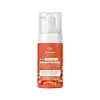Fresh Skinlab Tomato Glass Skin 3 In 1 Vitamin C Brightening Foam Cleanser Versus Cetaphil Gentle Skin Cleanser
What's inside
What's inside
 Key Ingredients
Key Ingredients

 Benefits
Benefits

 Concerns
Concerns

 Ingredients Side-by-side
Ingredients Side-by-side

Water
Skin ConditioningCocamidopropyl Betaine
CleansingButylene Glycol
HumectantMethyl Gluceth-20
HumectantHyaluronic Acid
HumectantHydrolyzed Collagen
EmollientPEG-60 Hydrogenated Castor Oil
EmulsifyingSolanum Lycopersicum Fruit Extract
AntioxidantCentella Asiatica Extract
CleansingPhenoxyethanol
PreservativeParfum
MaskingAllantoin
Skin ConditioningChlorphenesin
AntimicrobialPEG-12 Dimethicone
Skin ConditioningMelaleuca Alternifolia Leaf Extract
PerfumingVitis Vinifera Fruit Extract
Skin ConditioningHamamelis Virginiana Leaf Extract
Skin ConditioningCitric Acid
BufferingGlycyrrhiza Glabra Root Extract
BleachingMorus Alba Bark Extract
Skin ConditioningArbutin
AntioxidantDisodium EDTA
Portulaca Oleracea Extract
Skin ConditioningHydrolyzed Hyaluronic Acid
HumectantAscorbyl Glucoside
AntioxidantAscorbic Acid
AntioxidantWater, Cocamidopropyl Betaine, Butylene Glycol, Methyl Gluceth-20, Hyaluronic Acid, Hydrolyzed Collagen, PEG-60 Hydrogenated Castor Oil, Solanum Lycopersicum Fruit Extract, Centella Asiatica Extract, Phenoxyethanol, Parfum, Allantoin, Chlorphenesin, PEG-12 Dimethicone, Melaleuca Alternifolia Leaf Extract, Vitis Vinifera Fruit Extract, Hamamelis Virginiana Leaf Extract, Citric Acid, Glycyrrhiza Glabra Root Extract, Morus Alba Bark Extract, Arbutin, Disodium EDTA, Portulaca Oleracea Extract, Hydrolyzed Hyaluronic Acid, Ascorbyl Glucoside, Ascorbic Acid
 Reviews
Reviews

Ingredients Explained
These ingredients are found in both products.
Ingredients higher up in an ingredient list are typically present in a larger amount.
Citric Acid is an alpha hydroxy acid (AHA) naturally found in citrus fruits like oranges, lemons, and limes.
Like other AHAs, citric acid can exfoliate skin by breaking down the bonds that hold dead skin cells together. This helps reveal smoother and brighter skin underneath.
However, this exfoliating effect only happens at high concentrations (20%) which can be hard to find in cosmetic products.
Due to this, citric acid is usually included in small amounts as a pH adjuster. This helps keep products slightly more acidic and compatible with skin's natural pH.
In skincare formulas, citric acid can:
While it can provide some skin benefits, research shows lactic acid and glycolic acid are generally more effective and less irritating exfoliants.
Most citric acid used in skincare today is made by fermenting sugars (usually from molasses). This synthetic version is identical to the natural citrus form but easier to stabilize and use in formulations.
Read more about some other popular AHA's here:
Learn more about Citric AcidWater. It's the most common cosmetic ingredient of all. You'll usually see it at the top of ingredient lists, meaning that it makes up the largest part of the product.
So why is it so popular? Water most often acts as a solvent - this means that it helps dissolve other ingredients into the formulation.
You'll also recognize water as that liquid we all need to stay alive. If you see this, drink a glass of water. Stay hydrated!
Learn more about Water